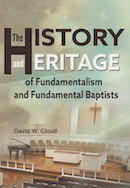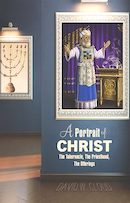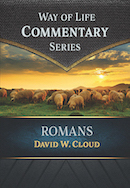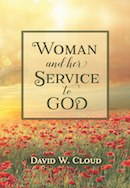Reference Bibles
866-295-4143, fbns@wayoflife.org
FEATURES OF A STANDARD REFERENCE BIBLE
The most basic reference Bible commonly has the following features:
1. Cross references
2. Chapter headings and dates
3. A brief concordance and/or dictionary
Usually the concordance in a study Bible is not very helpful because it is so limited, but the cross references are invaluable.
Beyond that, a more complete reference Bible contains many other features, such as the following:
4. Maps
5. Introductions and outlines of the books of the Bible
6. Notes and commentary
7. Topical studies
8. Larger dictionary
9. Larger concordance. The Scofield Bible contains an extensive and very helpful concordance. The Dugan Reference Bible, for instance, contains the complete Cruden’s Concordance.
THINGS TO BEWARE OF
1. Study Bibles often Use the Wrong Greek Text and Undependable English Versions. Most of the newer study Bibles are based on undependable English versions and incorporate corrupt readings from the modern critical Greek New Testament. These will have notes that say things such as “oldest and best manuscripts omit this verse” (Matthew 17:21) or “oldest and best manuscripts read he who instead of God” (1 Tim. 3:16). But this is misleading, because what they should say, in the majority of cases, is that one or two or at most a handful of old manuscripts make these changes whereas the vast majority of manuscripts read the same as the Received Greek New Testament underlying King James Bible. The Old Scofield Reference Bible, though based on the King James Bible, contains marginal notes supporting the modern critical text.
2. Study Bibles Can Contain Heretical Notes. Another problem with reference Bibles is that many of them contain false or misleading notes. As with commentaries, the student must be careful to “prove all things” (1 Thess. 5:21) and not merely believe everything that is written.
For example, Dake’s Annotated Reference Bible, edited by Finis Jennings Dake and published in 1961, was written by a Pentecostal, and his theology is reflected in his comments. A pamphlet that accompanies the Bible from the publisher claims that Dake received his teaching by divine revelation. Dake teaches that there was a pre-Adamite world ruled by Lucifer between Genesis 1:1 and 1:2, that healing is guaranteed for the Christian, that tongues are for today, that the believer can lose his salvation, that God has a body, that each member of the Trinity has his own soul and spirit, that God created the races to “reproduce after their kind,” and many other fanciful and false things.
Another example is the New Oxford Annotated Bible, edited by Bruce Metzger and Herbert May. It is filled with heretical modernistic notes. The notes claim that the Pentateuch is “a matrix of myth, legend, and history.” The worldwide flood of Noah’s day is said to be a mere “tradition” based on “heightened versions of local inundations.” The book of Job is called an “ancient folktale.” The book of Isaiah supposedly was written by at least three men. Jonah is called a “popular legend.” The HarperCollins Study Bible is also filled with this type of modernistic comments.
The notes in the New Jerusalem Bible and New American Bible contain Roman Catholic heresies. For example, they say that Matthew 16:18 refers to the pope.
SUGGESTED REFERENCE BIBLES
Old Scofield Reference Bible
The Scofield Reference Bible was edited by Cyrus Ingerson Scofield (1843-1921). He fought in the Civil War from 1861-1865 under General Robert E. Lee. Afterward he was a lawyer and served for one year in the Kansas House of Representatives. He was converted at 36. His first wife divorced him, but he was ordained in a Congregational church in 1882. Scofield later recalled two great events in his life: “The first was when I ceased to take as final human teachings about the Bible and went to the Bible itself. The second was when I found Christ as Victory and Achievement.” In 1884, he remarried. He pastored First Congregational Church of Dallas, Texas, and Trinitarian Congregational Church of Northfield, Massachusetts. In his later years, he traveled extensively preaching on biblical subjects. He did not have formal seminary training, but he was a diligent student. In 1890, he published the Scofield Correspondence Course, which was turned over to Moody Bible Institute in 1914. In 1890, Scofield also established the Central American Mission through the influence of talks with Hudson Taylor of China. Between 1904 and 1907, Scofield and his wife traveled to England and Switzerland three times to do research and prepare the notes for his reference Bible.
It was first published in 1909 by Oxford University Press, after the the deans and presidents of the colleges voted unanimously for its publication. An improved edition appeared in 1917, and this became the “Old Scofield.”
One million copies were sold by 1930, two million by the end of World War II, five million by the 21st century. It has been translated into German, French, Spanish, Portuguese, Hungarian, Swahili, and Russian.
The New Scofield Study Bible was published in 1967 and was revised and updated by many well-known dispensational Bible scholars, including E. Schuyler English, Charles Feinberg, Frank E. Gaebelein, Alva J. McClain, Wilbur M. Smith, and John F. Walvoord. The New Scofield contains more than 700 new footnotes and 15,000 new cross-references.
In 2019, one hundred and ten years after its first appearance, both the Old and the New Scofield are still published by Oxford Press. In addition, since the Old Scofield is in the public domain, it has been printed by some private publishers, such as Barbour and Local Church Bible Publishers.
The Scofield Reference Bible is packed with Bible helps. It has introductions to each book of the Bible, dates of events at the top of each column (based on James Ussher), paragraph headings, word definitions, cross-references, notes, concordance, maps. It has a system of chain references that trace major topics through the Bible. Scofield had a gift of systematizing and encapsulating. The notes are succinct but thorough and a great many of them are very helpful, such as the studies on the Levitical offerings and the comments on the prophetic books. The paragraph headings in the Gospels include parallel passages. The Scofield Reference Bible is dispensational and conservative, meaning rejects theological liberalism.
The 1917 Scofield Reference Bible, though based on the King James Bible, contains marginal notes supporting the modern critical Greek text.
Speaking to the students of Dallas Theological Seminary in about the 1930s, Lewis Sperry Chafer, who knew Scofield personally and worked with him in founding the Philadelphia School of the Bible, defending the Scofield Bible against a statement of a seminary professor who had called it “a Bible of errors.” Chafer said, “Now I hold that the Scofield Bible is one of God’s most precious gifts to the church in the last days. ... I want to extend it just as far as every student who ever comes to Dallas Seminary. Don’t ever be a critic of a thing so wonderful as the Scofield Bible. I don’t doubt that you can find fault with something maybe. There are one or two places where, if I had made the definition, I would have changed it. But that doesn’t amount to anything. I am not in a position to criticize Dr. Scofield. And when some of these critics that are rising up to find fault with it produce something that is as great a blessing to the church as Dr. Scofield’s Bible then I would be glad to listen to them. But when their own testimony is a vacuum and empty, I am not going to pay much attention to what they say. Oh, how many lives have been changed and how many have been blessed in their study of the Scripture by just following through. ... It may be my privilege sometime to take some chapel hour to speak on the personal relationship and my opinion of this man [Scofield] whom I think is the greatest Christian that I ever knew—without any doubt—marvelous Christian, so wonderfully balanced in all his thinking and in all his teaching. I think he was the incomparable teacher of the past generation. There is no other one to compare with him. Not another one” (“A Voice from the Past,” Grace Gospel Press).
Problems include the following three: First, the erroneous gap theory is taught in Genesis 1:1-2. Second, the Scofield Bible from its inception has been committed to the critical Greek New Testament. For example, the note at Acts 8:37 says, “The best authorities omit v. 37.” The note at 1 John 5:7 says, “It is generally agreed that v. 7 has no real authority, and has been inserted.” Third, the New Scofield places its “better renderings” into the text itself thus modifying the King James Bible. We thus recommend the Old Scofield over the New.
Though not perfect by any means, we like the Old Scofield Reference Bible and have often used it.
KJV Classic Wide Margin Study Bible
This is an Old Scofield Bible with wide margins. It features cross references, a helpful concordance, a chain reference system that follows topics through the Bible, dates of events at the top of each column, paragraph headings, and notes and comments from a dispensational perspective.
The erroneous gap theory is taught in Genesis 1, and there are notes promoting the critical Greek New Testament.
The Thompson Chain-Reference Bible
The Thompson Chain-Reference Bible was the work of Frank C. Thompson (1858-1940), beginning in 1890 when he “saw the need for a well-organized reference Bible that would be of practical use to the layman as well as a minister.” He was a Methodist Episcopal preacher.
It was first published in 1908 by the Methodists Book Concern, and in 1913, Thompson joined with B.B. Kirkbride to found the Kirkbride Bible Company as the sole publisher of his study Bible. As of 2006, four million had been sold.
It has cross-references and marginal notes, an analysis of every book of the Bible, outlines of every book, extensive topical studies, biographical studies, a chronology of Bible prophecies, a harmony of the Gospels, a Bible atlas, a concordance, and archaeological studies, among other things. It contains over 100,000 topical references in over 8,000 chain topics. The main feature is a chain of references that trace a topic through the Bible and includes definitions and comments. For example, chain # 124, Amalek, begins at Genesis 36:12, continues in Exodus 17:8, and ends in 1 Chronicles 4:43.
There is very little space to write your own notes, and it is a large Bible and thus difficult to carry. The cross references are linked to the topical system and are not as simple and straightforward as those in other reference Bibles. The Thompson views the book of Revelation as history rather than prophecy.
The King James Study Bible
This is published by Jerry Falwell’s Liberty University and was previously called the Liberty Annotated Study Bible.
It has good cross references, concordance, color maps, a harmony of the Gospels, conservative introductions to each book, doctrinal studies, prophecies, the miracles and parables of Christ, archaeological research proving the accuracy of the Bible, weights and measures, and biographies. The notes are written from a baptistic, non-Calvinist, dispensational, pre-tribulational viewpoint.
There are some critical notes, such as the one at Daniel 3:25, which says, “like the Son of God” - “Or a son of the gods,” or the one at Mark 16:9-20, which says, “Ancient manuscripts contain two different endings for Mark. .. In light of the uncertainty attached to verses 9-20, it may be advised to take care in basing doctrine upon them...”
The KJV Common Man’s Reference Bible
It has 60,000 cross references, dates, 3,000 footnotes and study notes, chapter headings, color maps, and wide margins on all four sides.
Large Print Wide Margin Reference Bible by Hendrickson Publishers
It has a cross references, a concordance, and wide margins on three wides of the text.
Cambridge Concord Wide Margin Bible
It features wide margins on all four sides, cross references, concordance, maps, and 56 blank pages for notes.
copyright 2013, Way of Life Literature
- Receive these reports by email
- "About" David Cloud
- www.wayoflife.org
______________________
Sharing Policy: Much of our material is available for free, such as the hundreds of articles at the Way of Life web site. Other items we sell to help fund our expensive literature and foreign church planting ministries. Way of Life's content falls into two categories: sharable and non-sharable. Things that we encourage you to share include the audio sermons, O Timothy magazine, FBIS articles, and the free eVideos and free eBooks. You are welcome to make copies of these at your own expense and share them with friends and family, but they cannot be posted to web sites. You are also welcome to use excerpts from the articles in your writings, in sermons, in church bulletins, etc. All we ask is that you give proper credit. Things we do not want copied and distributed freely are items like the Fundamental Baptist Digital Library, print editions of our books, electronic editions of the books that we sell, the videos that we sell, etc. The items have taken years to produce at enormous expense in time and money, and we use the income from sales to help fund the ministry. We trust that your Christian honesty will preserve the integrity of this policy. "For the scripture saith, Thou shalt not muzzle the ox that treadeth out the corn. And, The labourer is worthy of his reward" (1 Timothy 5:18).
Goal:Distributed by Way of Life Literature Inc., the Fundamental Baptist Information Service is an e-mail posting for Bible-believing Christians. Established in 1974, Way of Life Literature is a fundamental Baptist preaching and publishing ministry based in Bethel Baptist Church, London, Ontario, of which Wilbert Unger is the founding Pastor. Brother Cloud lives in South Asia where he has been a church planting missionary since 1979. Our primary goal with the FBIS is to provide material to assist preachers in the edification and protection of the churches.
Offering: We take up a quarterly offering to fund this ministry, and those who use the materials are expected to participate (Galatians 6:6) if they can. We do not solicit funds from those who do not agree with our preaching and who are not helped by these publications. We seek offerings only from those who are helped. OFFERINGS can be mailed or made online with with Visa, Mastercard, Discover, or Paypal. For information see: www.wayoflife.org/about/makeanoffering.html.





